“`xml
The Indonesian military, officially known as Tentara Nasional Indonesia (TNI), is vital in protecting the world’s largest archipelagic nation.
Since its establishment in 1945, the TNI has undergone considerable transformation.
Today, Indonesia’s armed forces stand as a powerful force in Southeast Asia, boasting an estimated 300,400 active personnel in the Army alone.
Operating under a distinctive military philosophy termed “Total People’s Defense,” the TNI integrates conventional military operations with guerrilla warfare techniques.
This strategy is a reflection of Indonesia’s varied geography, which necessitates the protection of its extensive coastline and numerous islands.
In recent years, Indonesia has made significant investments in modernizing its military, focusing on improving its defense readiness and strengthening its influence in the region.
As you delve into Indonesia’s military dynamics, you’ll uncover a multifaceted organization rich in history and with ambitious aspirations for the future.
From maintaining internal security to engaging in international peacekeeping missions, the TNI actively contributes to shaping Indonesia’s presence on the global stage.
Key Takeaways
- Indonesia’s military ranks among the top 15 global military powers, featuring a unique defense strategy tailored to its archipelagic characteristics.
- The TNI is not only modernizing its capabilities but also enhancing its influence in regional security affairs.
- Indonesia’s armed forces perform a variety of roles, ranging from national defense to participating in international peacekeeping missions.
Historical Context of Indonesian Armed Forces
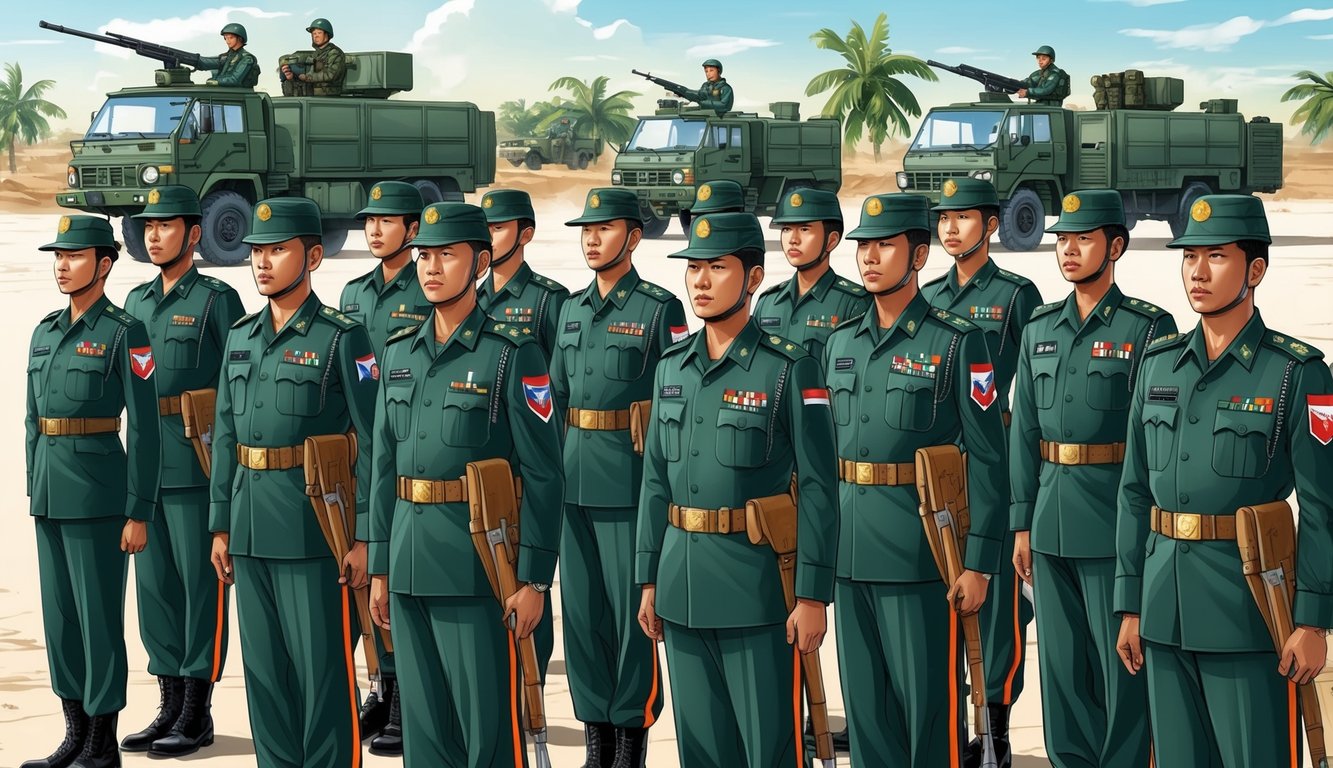
The history of the Indonesian armed forces is intricate, shaped by colonial rule, revolutionary zeal, and internal strife.
Its development mirrors Indonesia’s fight for independence and the ongoing quest for national unity.
Indonesian National Revolution
The military’s origins trace back to the revolution against Dutch colonial rule from 1945 to 1949.
During this period, local militias and former colonial troops united to form the People’s Security Army (TKR), which engaged in guerrilla warfare, ultimately compelling the Dutch to recognize Indonesia’s independence.
This TKR laid the groundwork for what would become the modern Indonesian National Armed Forces (TNI).
Prominent military leaders, like Sudirman, emerged during this era as national figures, playing pivotal roles in securing Indonesia’s sovereignty and shaping its national identity.
Japanese Occupation and PETA
Before the revolutionary period, the Japanese occupation from 1942 to 1945 contributed to the military’s development in unexpected ways.
The Japanese established a local auxiliary force known as PETA (Defenders of the Homeland).
PETA trained thousands of Indonesians in military techniques, an experience that proved vital during the subsequent struggle for independence.
Many PETA officers would become significant figures within the Indonesian military and government.
Post-Independence Conflicts
Following independence, the Indonesian military encountered several challenges, including the Madiun Affair in 1948, where a communist uprising was swiftly quelled by government forces, and the failed APRA coup attempt in 1950 by former Dutch special forces.
The 1950s also saw various regional rebellions, such as the Darul Islam movement.
These conflicts were critical in testing the military’s loyalty and capabilities, ultimately shaping its identity as a defender of national unity and the state ideology, Pancasila.
Suharto Era and Military Dual Function
The influence of the military peaked during Suharto’s New Order regime from 1966 to 1998, marked by the implementation of dwifungsi (dual function), where the military took on both defense and socio-political responsibilities.
This doctrine saw military personnel occupying significant government roles and seats in parliament, leading to the military’s extensive involvement in domestic security and economic activities.
While this expanded the military’s authority, it also raised concerns about human rights violations and corruption.
The fall of Suharto in 1998 initiated a process of reform aimed at curbing the military’s political influence, yet the legacy of this period remains a crucial factor in current civil-military relations in Indonesia.
Structure and Organization
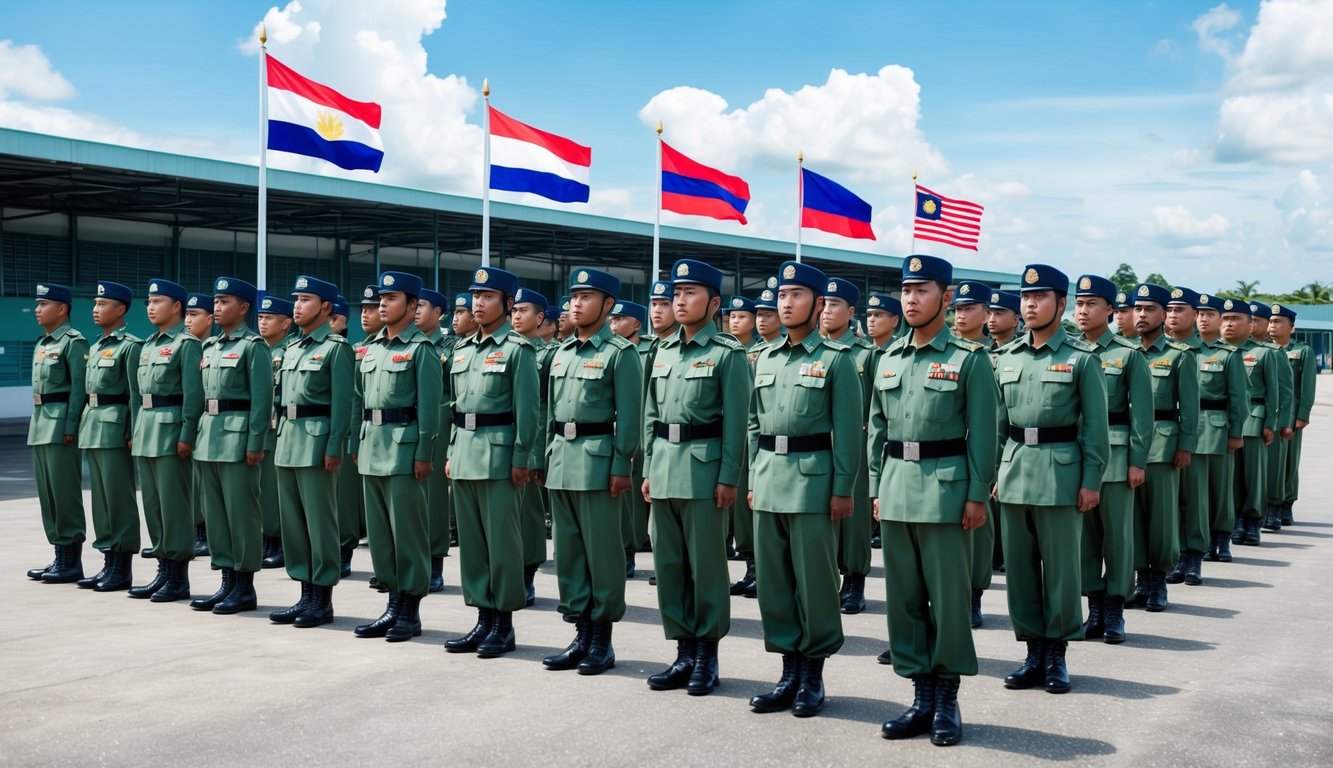
The Indonesian military is structured to address the unique needs of safeguarding the nation’s extensive archipelago.
Different branches and specialized units collaborate to ensure Indonesia’s sovereignty and security.
Indonesian National Armed Forces
The backbone of Indonesia’s military is the Tentara Nasional Indonesia (TNI), which consists of three primary branches: the Army (TNI-AD), Navy (TNI-AL), and Air Force (TNI-AU).
Each branch serves distinct functions, with the Army focused on land operations, the Navy safeguarding Indonesia’s waters, and the Air Force defending the nation’s airspace while providing aerial support.
The TNI also encompasses the Indonesian Marine Corps, part of the Navy, tasked with amphibious operations and coastal defense.
Military Regional Command
Indonesia’s vast territory is divided into multiple Military Regional Commands known as Kodam.
Each command, responsible for a specific geographic area, facilitates rapid local response to threats, ensuring efficient resource allocation and coordination with regional governments.
Each Kodam encompasses its own troops, equipment, and support units, thereby enabling the military to effectively address Indonesia’s diverse security challenges.
Strategic Reserve Command
The Strategic Reserve Command, or Kostrad, functions as Indonesia’s rapid deployment force, prepared to respond swiftly throughout the nation.
Kostrad is characterized by highly-trained personnel, advanced equipment, and specialized airborne and mechanized units, playing a vital role in national defense and crisis response.
Special Forces Command (Kopassus)
Kopassus represents Indonesia’s elite special forces unit, known for its participation in various high-stakes operations such as counter-terrorism, intelligence gathering, and hostage rescues.
These soldiers undergo rigorous training and selection processes, operating in small teams for both domestic and international missions, with their skills in unconventional warfare making them critical assets to Indonesia’s military framework.
Defense Policy and Modernization
Indonesia’s military is experiencing substantial changes aimed at enhancing its capabilities and strategic outlook.
The government focuses on modernizing its armed forces and developing local defense industries.
Minister of Defense’s Role
Prabowo Subianto, as the current Minister of Defense, is pivotal in shaping Indonesia’s defense policy.
His tenure has seen the initiation of extensive modernization initiatives designed to strengthen the country’s deterrence capabilities.
Working closely with President Joko Widodo, Prabowo aligns defense strategies with national priorities, aiming to bolster Indonesia’s military strength while considering economic factors.
Military Modernization Initiatives
The modernization of Indonesia’s military is underway, with efforts focused on upgrading outdated equipment and acquiring new technological advancements.
Recent acquisitions include Rafale fighter jets from Dassault and potential purchases of F-15s from Boeing.
The goal of these acquisitions is to enhance Indonesia’s air defense capacity while modernizing the navy, which plans to expand its submarine and surface vessel fleet.
This modernization initiative seeks to establish a more flexible and robust military capable of addressing regional security challenges and protecting Indonesia’s expansive territory.
Technology Transfer and Indigenous Production Capabilities
Indonesia aims to boost its domestic defense industry by actively pursuing technology transfer agreements across military procurement deals.
The objective is to reduce reliance on foreign manufacturers and enhance local capabilities.
State-owned shipbuilder PT PAL leads these efforts, focusing on domestic warship production, while similar initiatives are taking place in the aerospace sector through partnerships with companies like Airbus and Lockheed Martin.
By cultivating indigenous manufacturing capacities, Indonesia strives to create jobs, conserve foreign currency, and attain greater self-sufficiency in defense, aligning with broader economic development goals.
Military Capabilities
The Indonesian armed forces are equipped with diverse capabilities covering land, sea, and air, with an ongoing emphasis on modernization to improve both defensive and offensive capabilities, adapting to evolving security needs.
Land Warfare Capabilities
The Indonesian army comprises a mix of modern and older armored vehicles, including several hundred tanks, such as Leopard 2A4 main battle tanks, along with lighter armaments like the Harimau.
Mobility and protection are further enhanced by armored personnel carriers and infantry fighting vehicles.
Artillery units are equipped with various towed and self-propelled guns, in addition to multiple rocket launcher systems.
Special forces units are trained specifically for counter-terrorism and jungle warfare operations, reflecting the geographical diversity of Indonesia.
The army also maintains engineering units responsible for infrastructure support and disaster response, crucial in a country prone to natural disasters.
Naval Power and Maritime Assets
The Indonesian navy faces the significant responsibility of patrolling the expansive archipelagic waters, employing a fleet that includes frigates, corvettes, and patrol vessels.
Key assets feature the Martadinata-class frigates and KCR-60M fast attack craft.
Submarine capabilities are set to grow, with Type 209 submarines currently in service and plans for acquiring more advanced models.
Additionally, amphibious warfare ships bolster Indonesia’s island defense strategy.
The navy also operates maritime patrol aircraft and helicopters for surveillance and anti-submarine operations.
Strategically positioned coastal defense systems and naval bases across the archipelago are essential for securing maritime interests and trade routes.
Air Defense and Airpower
Indonesia’s air force is on a modernization trajectory, with a fleet of fighter jets that includes Su-30s, F-16s, and domestically developed KF-X/IF-X fighters currently under development.
Transport aircraft like the C-130 Hercules facilitate logistics and humanitarian operations.
Indonesia’s air defense systems combine older Soviet-era technology with recent acquisitions, supported by ground-based radar networks and surface-to-air missile systems that constitute the backbone of its air defense architecture.
Unmanned aerial vehicles are increasingly employed for reconnaissance, and helicopters play crucial roles in supporting ground operations and search-and-rescue missions across Indonesia’s varied landscapes.
Defense Economics
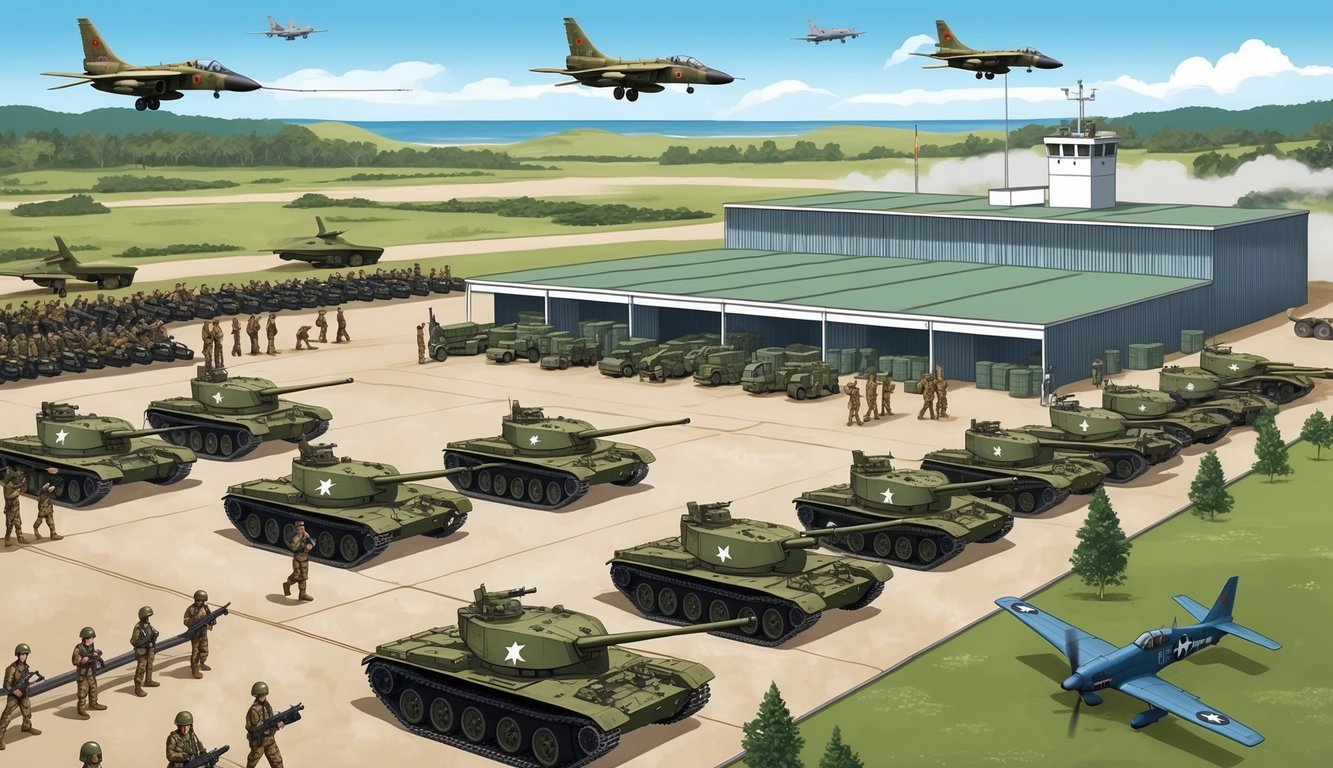
Indonesia’s military budget and personnel reflect its strategic objectives as a substantial archipelagic nation, with significant investments directed toward naval and air capabilities complemented by a robust ground force for comprehensive territorial protection.
National Defense Budget
Indonesia’s defense budget has seen consistent growth in recent years, reaching $8.8 billion in 2023, with expectations for further increases.
Projections indicate a 2.2% annual growth rate in upcoming years.
The intention is to modernize military equipment and improve technological capabilities, driving much of the budget expansion.
Key investment areas encompass:
- Naval vessels for maritime security
- Advanced fighter jets
- Radar and surveillance systems
- Cyber defense capabilities
Manpower and Reserve Forces
Indonesia maintains one of the largest armed forces in Southeast Asia, with the following manpower distribution:
- Active personnel: Approximately 400,000
- Available manpower: Over 130 million (ages 16-49)
- Reserve personnel: Around 400,000
A significant paramilitary force of about 280,000 personnel operates alongside the regular military, providing auxiliary support.
Indonesia’s large population creates an extensive pool for potential recruits; however, the emphasis is shifting towards building a more professional and well-trained military force rather than prioritizing sheer numbers.
Military Operations and Roles
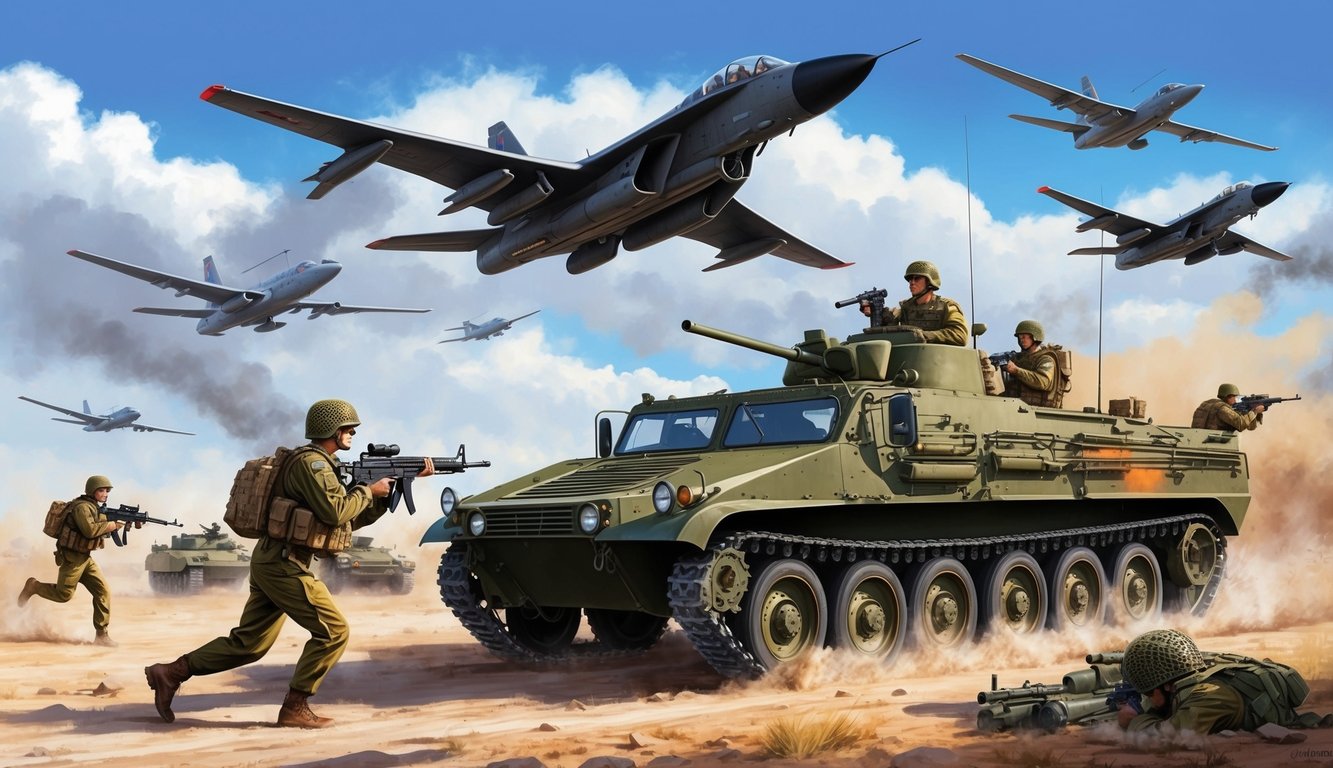
The Indonesian military partakes in a range of operations aimed at safeguarding national security and contributing to international peacekeeping initiatives.
These undertakings include internal security efforts, peacekeeping missions, and regular training exercises to maintain operational readiness.
Internal Security Operations
The military plays a critical role in maintaining internal security.
Ongoing operations, such as Madago Raya in Central Sulawesi, focus on addressing militant threats to civilians.
This mission aims to neutralize extremist factions and restore order in the region.
Additionally, during natural disasters, the military collaborates with civil authorities to provide crucial aid and rescue services following earthquakes or tsunamis.
In Papua, Operation Cartenz’s Peace works to sustain stability and counter separatist movements, requiring sensitivity to local communities while ensuring security.
International Peacekeeping and UN Missions
Indonesia’s dedication to global peacekeeping is evident through its contributions to UN missions.
Indonesian troops, known as the Garuda Contingent, actively participate in various conflict zones worldwide.
They engage in missions such as:
- Lebanon (UNIFIL)
- Congo (MONUSCO)
- Central African Republic (MINUSCA)
Their responsibilities range from civilian protection to facilitating political processes.
Indonesian peacekeepers are recognized for their professionalism and cultural sensitivity, making them valuable contributors in complex international contexts.
Military Exercises and Training
Indonesian forces routinely participate in training exercises to ensure preparedness, spanning from small drills to extensive multinational operations.
Examples of exercises include:
- Joint drills with ASEAN partners
- US-led Cobra Gold in Thailand
- Australian-Indonesian Exercise Wirra Jaya
These initiatives enhance interoperability with allied forces and test new tactical approaches.
They also function as diplomatic tools, strengthening military cooperation in the region.
Training emphasizes modern combat techniques, including cyber defense and counter-terrorism.
Furthermore, considerable focus is placed on disaster response readiness, given Indonesia’s susceptibility to natural disasters.
Indonesia’s Role on the Global Stage
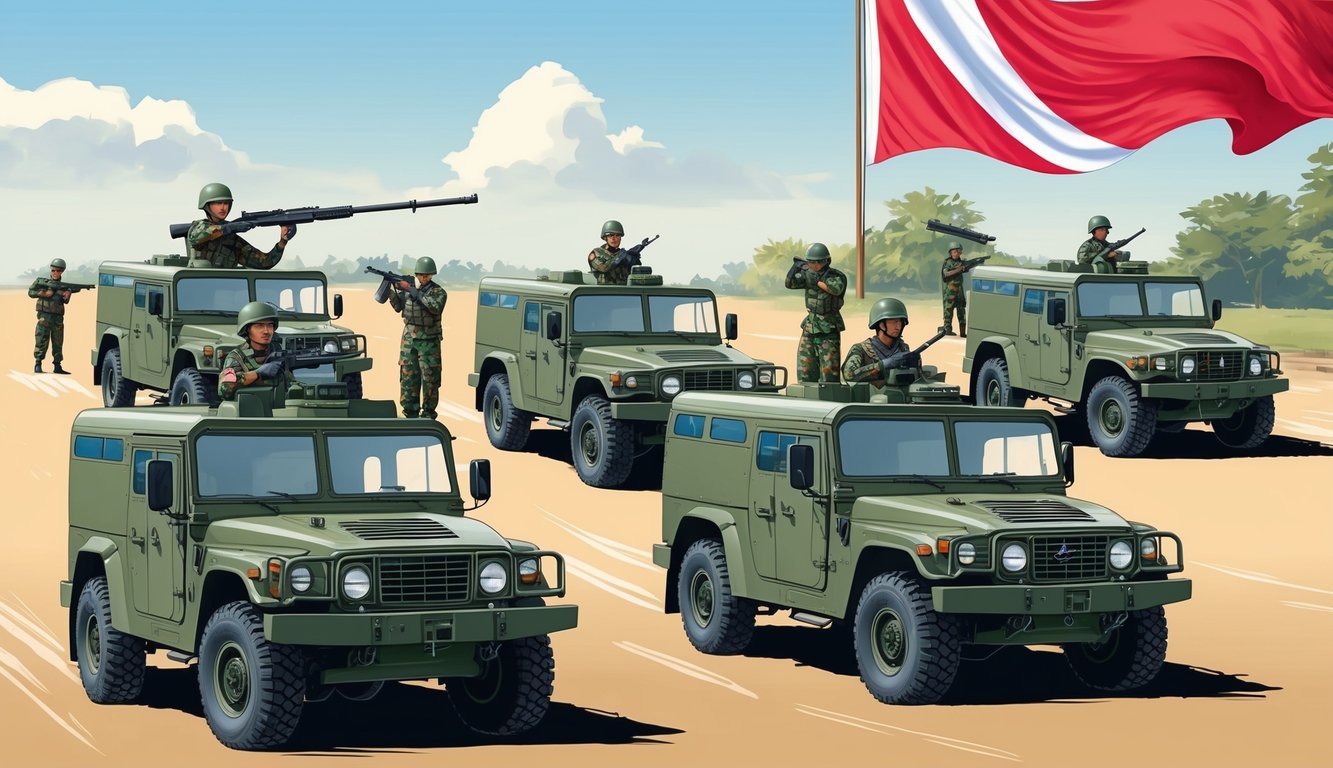
Indonesia’s ascending prominence in international affairs mirrors its strategic location and economic potential.
The country is increasingly asserting its influence on pivotal global matters while navigating regional partnerships and military modernization endeavors.
Foreign Policy and Defense Relations
Engagement in global diplomacy has amplified, with Indonesia expanding partnerships beyond Southeast Asia to include major powers such as the US, China, and the EU.
Its foreign policy seeks to uphold strategic autonomy while pursuing collaboration on mutual interests.
In terms of defense, Indonesia is focused on modernizing its military to safeguard its expansive archipelago.
Ranking 19th on GlobalFirepower’s 2024 Pwrindx underscores its advancing military capabilities.
The nation is investing in contemporary equipment and technologies to fortify its defense stance.
Participation in Regional Security
Indonesia’s role in regional security has become increasingly significant.
The country is taking a proactive stance within ASEAN, particularly on issues like maritime disputes and counterterrorism collaboration.
Joint military exercises with neighboring countries and global partners are part of these efforts, aimed at enhancing interoperability and fostering trust among regional forces.
Additionally, Indonesia is committed to mediating conflicts and reducing geopolitical tensions in Southeast Asia, engaging diplomats in multilateral discussions to advocate for peaceful resolutions to regional disputes.
Frequently Asked Questions
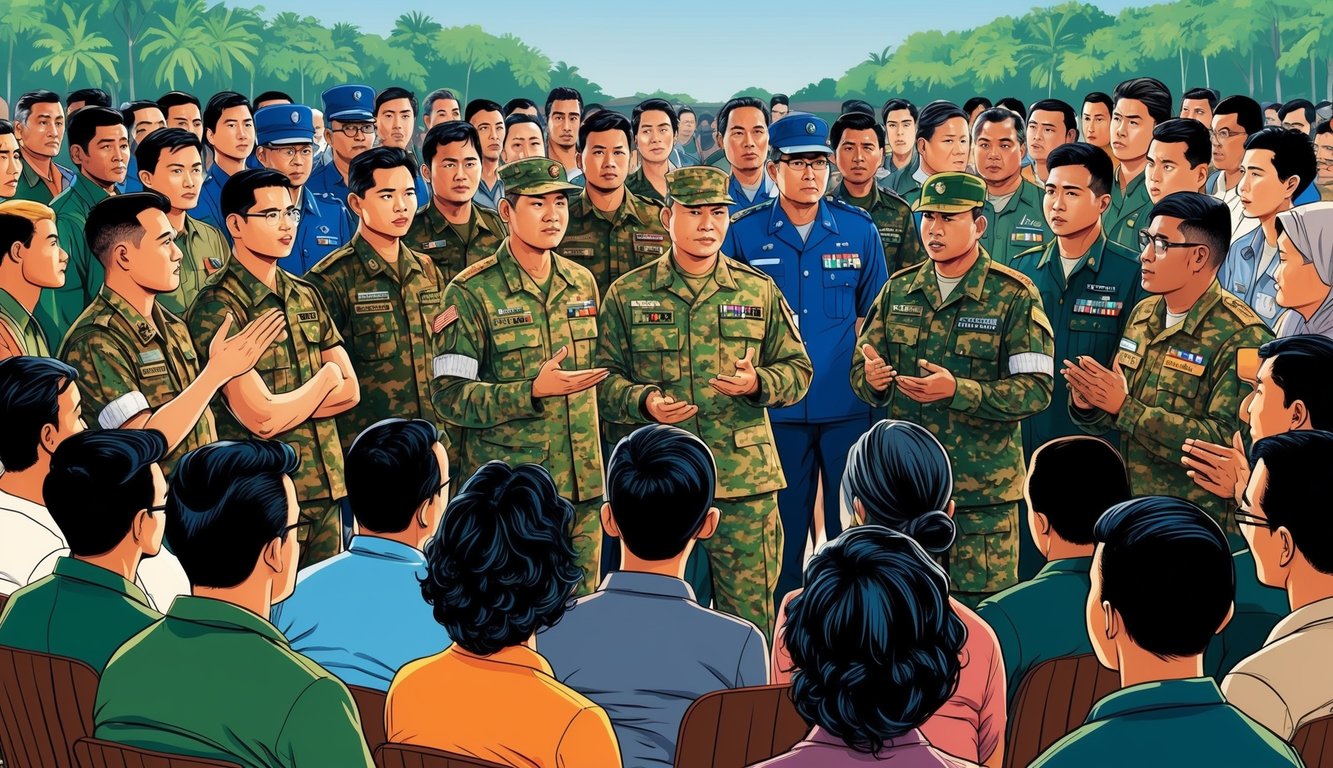
The structure of the Indonesian military is intricate, encompassing various ranks, uniforms, equipment, and specialized roles.
Its size and capabilities have adapted over time to meet the defense requirements of the country.
What are the different ranks within the Indonesian Army?
The Indonesian Army employs a rank hierarchy similar to many global militaries, including enlisted positions like Private and Corporal, non-commissioned officer ranks such as Sergeant, and commissioned officer ranks extending from Second Lieutenant to General.
The top rank is General, typically held by the Army Chief of Staff.
How has the Indonesian military uniform evolved over the years?
Indonesian military uniforms have undergone substantial changes since independence, initially influenced by Dutch colonial designs.
Modern uniforms feature digital camouflage patterns for combat wear, while ceremonial uniforms include traditional elements, showcasing Indonesia’s cultural legacy.
What kind of equipment is currently used by the Indonesian military?
The military utilizes a blend of domestically produced and imported equipment, covering tanks, armored personnel carriers, artillery, and helicopters.
The navy incorporates frigates, submarines, and patrol crafts into its arsenal, while the air force operates fighter jets, transport aircraft, and attack helicopters.
How large is the Indonesian Army?
The Indonesian Army stands as the largest branch of the military, with around 300,000 active personnel, making it one of the more substantial armies in Southeast Asia and reflecting Indonesia’s strategic significance in the region.
What constitutes Indonesia’s military strength in present times?
Indonesia’s military strength stems from a combination of substantial personnel, diverse equipment, and a strategically advantageous location.
The vast archipelago necessitates a capable navy and air force.
Ongoing modernization efforts are focused on acquiring new technologies and fortifying capabilities to address shifting security dynamics.
Which special forces units are operative within the Indonesian military?
Indonesia’s military encompasses several elite special forces, with Kopassus being the most prominent among them.
The navy has KOPASKA, its frogman unit, while the air force features Paskhas, dedicated to special operations.
These units are adept at executing complex missions and counterterrorism operations.
“`

